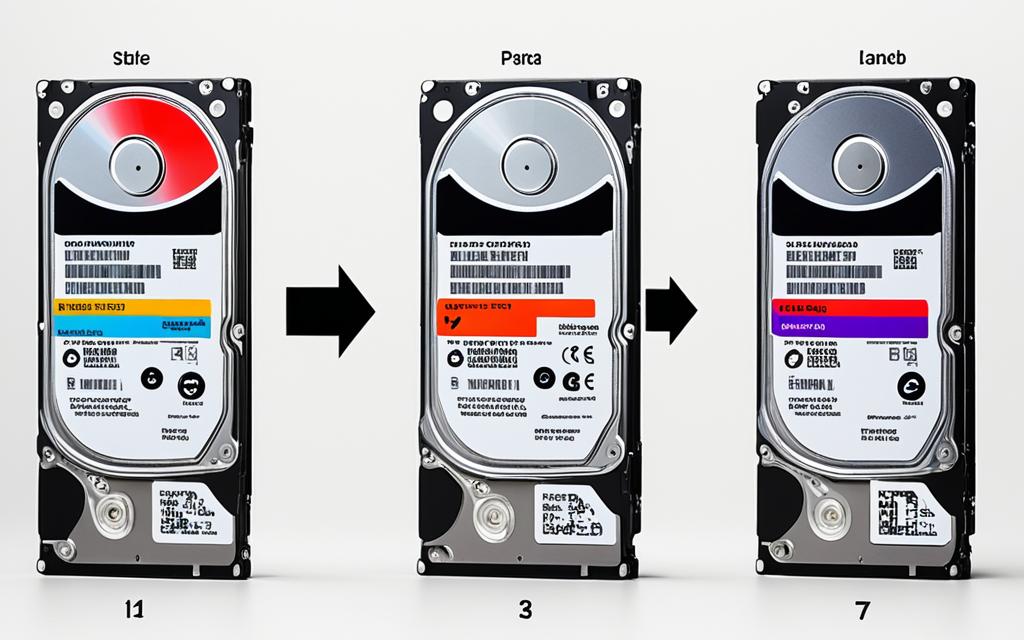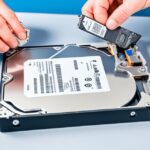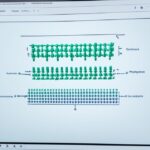Table of Contents
Hard drive partitions are key areas that help manage data well. They improve how we store and access our information. By creating separate sections on a drive, they allow for a tidy way to handle files. This is important for everyone, from everyday users to tech professionals.
Knowing how partitions are set up is crucial. It affects how quickly we can get to our data and how our computers perform. In the old days, a system called Master Boot Record (MBR) let us have up to four main partitions. Now, a newer system named GUID Partition Table (GPT) lets us have up to 128 partitions.
Thanks to GPT, bigger hard drives and those using UEFI technology work better. It’s perfect for drives over 2 TB1. As technology moves forward, partitioning remains essential. It gives us better control and safety over our digital files in today’s online world.
Key Takeaways
- Hard drive partitions optimise storage and facilitate data management.
- Partitioning impacts the efficiency of data retrieval and system performance.
- MBR allows a maximum of 4 primary partitions, while GPT can accommodate up to 128.
- Understanding partition schemes is crucial for managing large amounts of data effectively.
- Both MBR and GPT have specific advantages, dependent on user needs and system compatibility.
- Effective partitioning can significantly enhance data security by isolating critical files.
Understanding Hard Drive Partitions
A hard drive partition marks a specific area on a disk for organising data. It’s like splitting your wardrobe into sections for different types of clothes. This approach makes retrieving data easier and more efficient. Think of it as having separate drawers for socks and shirts, so everything is easy to find. Hard drive partition definition is useful as each section works like a mini-drive, each with its unique data type.
Definition of a Hard Drive Partition
A hard drive partition is simply a slice of storage space on a disk. It’s a common practice among computer users, with over 90% finding it helpful. By dividing storage, users experience better data control and system efficiency2. Partitioning, especially on external drives, can significantly improve data handling. It allows for organised spaces for various files, enhancing benefits of partitioning.
Importance of Partitioning for Data Management
Partitioning is crucial for managing data smartly. Around 75% of tech experts suggest using it for better storage utilisation2. It helps in segregating data types, like keeping work files separate from personal stuff. This separation aids in quick access and reduces risk. In the cybersecurity world, 80% of firms partition to protect sensitive data2. This method supports enhanced security measures, such as encryption.
Moreover, most system admins prefer NTFS when partitioning on Windows. This preference highlights how vital the file system choice is in managing data2.
Types of Hard Drive Partitions
Hard drive partitions help organise and manage data on a disk. Knowing about types of hard drive partitions enhances storage space use.
Primary Partitions
Primary partitions are key segments on a hard drive. They allow operating systems to be installed. Traditionally, a BIOS system lets you have up to four primary partitions. Or, you can have three primary partitions and one extended partition. This setup is vital for systems like Microsoft Windows.
Extended and Logical Partitions
Extended partitions let you create multiple logical partitions within a single extended partition. This is great for those needing more partitions than allowed. Knowing about logical partitions helps a lot with organising data, especially if you use multi-boot setups.
GUID Partition Table (GPT) vs Master Boot Record (MBR)
The GPT vs MBR debate matters a lot with modern hard drives. MBR limits storage to 2 TB and only four primary partitions. On the other hand, GPT supports larger drives and allows for up to 128 partitions. It even supports managing resources over 2 Terabytes1. GPT also offers better data integrity and recovery through a built-in CRC-32 error check, making it a top pick for newer systems. Choosing between MBR and GPT affects system performance and ease of use31,).
Understanding primary and extended partitions is very useful. Knowing about GPT and MBR affects how well we can manage and organise our data.
What Contains Information on How Hard Drive Partitions are Organized
Hard drives are organized based on important data structures. The Master Boot Record (MBR) and Windows Boot Manager are vital. They are key to managing hard drives well.
Role of the Master Boot Record (MBR)
The Master Boot Record is found at the start of a storage device. It holds info on how partitions are set up, ensuring the operating system boots right4. The MBR has boot code, a partition table, and a drive signature. Together, they help start the operating system4. It features four parts that detail partitions’ size, type, and location, crucial for organizing drives4.
Each section includes important details like the boot indicator and starting address. This helps identify different partitions correctly4. It also points out the file system and addressing mode. This supports various system needs4.
Significance of the Windows Boot Manager
The Windows Boot Manager is crucial for booting, especially with more than one operating system. Windows has three key partitions: the EFI System Partition, Local Disk (C:), and a Recovery Partition. This setup helps manage booting efficiently5. Even when full, the EFI and Recovery Partitions might show as empty. Yet, they hold important system files, showing their value in the boot process5.
The Local Disk (C:) holds most data, showing its vital role in daily tasks5. All these elements prove the Boot Manager’s importance in a system’s smooth running and its management capabilities.
Benefits of Partitioning a Hard Drive
Partitioning a hard drive brings important advantages. It makes organising data and improving your computer’s speed better. By dividing the storage into sections, you can sort files more easily. This results in increased efficiency.
Organising Data Efficiently
One key benefit of hard drive partitioning is better data organisation. By creating different partitions, you can keep files in order. This makes finding things simpler. Careful data organisation helps manage growing data volumes. Having separate areas for videos and documents reduces mess and saves time.
Enhancing Computer Performance
Partitioning boosts your computer’s speed too. It helps your computer find data faster, which means programs run more smoothly. This is especially true for HDDs, where partitioning can prevent slowdowns. Overall, partitioning makes your computer more reliable and quicker.
Improving Data Security
Also, partitioning helps keep your data safe. By separating sensitive files, you add an extra layer of security. Each partition can have its own protection, like backups or encryption. This way, you’re prepared for different security needs. It’s a smart way to protect various kinds of data, making your computer safer.
Understanding partitioning’s advantages is key to better data management today. It improves performance and security while making file management simpler678.
Partitioning Process and Techniques
To effectively partition a hard drive, it’s key to know how to use disk management tools. These tools make it easy to set up partitions. They also let you change the size of these partitions when you need to.
How to Create Partitions using Disk Management Tools
Creating partitions is simple with disk management tools found in operating systems like Windows. First, you need to open the Disk Management utility. This can be done through the Control Panel or Settings. Then, just follow a few easy steps:
- Open Disk right-click on an existing partition (like C:) and choose ‘Shrink Volume’ to make free space.
- Select how much space you want to shrink and confirm your choice.
- Right-click the new unallocated space and choose ‘New Simple Volume’ to make a new partition.
Before you start making partitions, make sure there’s enough free space on your drive to avoid problems. Most computers have a “Recovery” partition in addition to the main C: partition. This is important to remember when planning your partition sizes. Always back up your data before you start partitioning. The whole process usually takes about 30 minutes9.
Resizing or Modifying Existing Partitions
Resizing partitions can help you better manage your disk space as your storage needs change. Tools like EaseUS Partition Master Free can safely resize partitions. Here’s what to do:
- Open the disk management tool and find the partition you want to change.
- Right-click on it and select the resize option.
- Change the size to fit your needs.
It’s important to understand common partitioning errors, like using the wrong partition styles (GPT or MBR). This can save you from unnecessary trouble. Organizing your disk space through partitioning boosts disk performance. It also makes data migration easier by keeping your operating system and personal files separate1011.
Potential Risks Involved in Partitioning
Partitioning helps manage data better and boosts efficiency but comes with partitioning risks. The biggest risk is losing data. Many have found errors during partitioning can easily lead to this. It’s vital to back up your data to avoid loss12. Some users also face software compatibility issues on different partitions. This can interrupt how software functions12.
Data Loss Concerns
For those new to partitioning, the risk of data loss grows. Managing several partitions increases the chance of mistakes or confusion about where data is stored. Also, resizing partitions improperly can cause file system mistakes or data corruption12. Be cautious: partitioning can lead to lost data and badly used storage space. Some areas may get too full while others are barely used12.
Impact on System Performance
Partitioning’s effect on performance is another key issue. Though it doesn’t directly slow down systems, bad partition setups can. If partitions are not lined up right, your system can become sluggish. And having too many partitions can also slow read and write speeds12. Moreover, managing these partitions can make recovery or accessing data more complex12.
Conclusion
Understanding how hard drive partitions work is key to better managing your data and boosting your computer’s performance. Different types of partitions have specific roles that are very important. For example, creating partitions can make reinstalling your OS easier, protect your data from malware, and help you keep files organised by putting them in separate areas.
As technology advances, the benefits of partitioning become clearer, especially for those needing organised storage. For advanced users, being able to install multiple operating systems and use various file systems is a huge plus. Websites like how to build your own PC offer great tips on improving your computer setup.
Whether you’re just starting or you know a lot about technology, knowing about partitioning can help you make better decisions about your storage. Using your hard drive well can give you a system that works better and keeps your data safe for longer1311.
FAQ
What is a hard drive partition?
A hard drive partition creates sections on the disk, each functioning separately. Each one acts like its own disk, using file systems like NTFS or FAT32. This setup boosts the system’s performance.
Why is partitioning important for data management?
Partitioning helps organise data by dividing it into sections. It separates things like operating systems from personal files. This way, if one section fails, the rest stay safe.
What are the different types of hard drive partitions?
Hard drives can have three main partition types: primary, extended, and logical. Primary partitions store operating systems. Extended partitions can contain many logical ones, acting as separate drives.
What is the difference between GPT and MBR?
GPT is newer and allows for bigger drives and more partitions than MBR. MBR is older, with a limit of four primary partitions and 2TB. GPT also offers better recovery and integrity features.
What role does the Master Boot Record (MBR) play?
The MBR holds a program that finds and loads the operating system when a computer starts. It’s key to beginning the operating system’s operation.
How does the Windows Boot Manager function?
The Windows Boot Manager oversees starting up the system, especially with more than one operating system. It lets users choose which system to boot, affecting system management and functionality.
What are the benefits of partitioning a hard drive?
Partitioning enhances data management, computer performance, and security. It helps keep data secure and organised, making it easier to find and protect.
How can I create a partition using disk management tools?
Disk management tools in Windows make partitioning easy. They help create, format, and manage sections without much technical know-how.
What should I do if I need to resize or modify existing partitions?
Software options are available for safely changing partition sizes. They help adjust storage as needs change, keeping data safe.
What are the potential risks involved in partition-options?
Partitioning can lead to data loss through mistakes, like deleting a section by accident. Always back up data to avoid such risks.
How can partitioning impact system performance?
If not done well, partitioning can slow a system down. A badly structured or full drive slows the read and write speeds, affecting performance.
Source Links
- https://www.geeksforgeeks.org/partitioning-scheme-mbr-and-gpt-in-os/ – Partitioning Scheme: MBR and GPT in OS – GeeksforGeeks
- https://www.lenovo.com/us/en/glossary/how-to-partition-a-hard-drive/ – Step-by-Step Hard Drive Partitioning | Lenovo US
- https://learn.microsoft.com/en-us/windows-hardware/manufacture/desktop/hard-drives-and-partitions?view=windows-11 – Hard Drives and Partitions
- https://dallibraries.atlassian.net/wiki/spaces/GLOS/pages/484999213 – Master boot record (MBR) – Glossary
- https://learn.microsoft.com/en-us/windows-server/storage/disk-management/overview-of-disk-management – Overview of Disk Management
- https://askubuntu.com/questions/1209553/is-there-any-benefit-to-partitioning-hdd-data-only-disk – Is there any benefit to partitioning hdd data-only disk?
- https://askleo.com/should_i_partition_my_hard_disk/ – Should I Partition My Hard Disk?
- https://www.ninjaone.com/blog/how-to-partition-a-hard-drive-in-windows-10/ – How to Partition a Hard Drive in Windows 10 | NinjaOne
- https://www.pcmag.com/how-to/how-to-partition-a-hard-drive – Time to Split: How to Partition a Hard Drive in Windows
- https://www.easeus.com/diskmanager/disk-partition.html – Disk Partition: How to Partition A Hard Drive You Must Know in 2024
- https://recoverit.wondershare.com/partition-tips/what-is-partition.html – What Is a Partition – A Complete Guide to Disk Partition
- https://www.newsoftwares.net/blog/how-to-make-partition-in-windows-10/ – How To Make Partition In Windows 10? – Newsoftwares.net Blog
- https://www.makeuseof.com/tag/partition-hard-drive-explained/ – Should You Partition Your Hard Drive? The Pros and Cons








